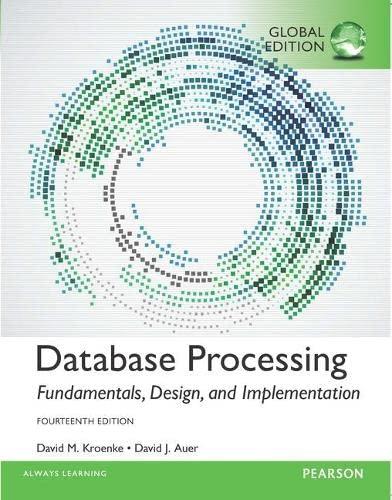Question
JAVA Write a method splitQueue to be outside ArrayQueue class and accepts three parameters q1,q2 and q3 of type ArrayQueue. The method splits q1 into
JAVA
Write a method splitQueue to be outside ArrayQueue class and accepts three parameters q1,q2 and q3 of type ArrayQueue. The method splits q1 into q2 and q3 by copying the elements of q1 alternately in q2 and q3. If q1 is empty the method returns false, otherwise, it returns true.
Before run:
front rear
q1: 3 4 7 8 9 2 5
After run:
front run
q2: 3 7 9 5
front rear
q2: 4 8 2
public static
{
} // I WILL PROVIDE THE ARRAYQUEUE IMPLEMENTAITON PLEASE ONLY DO THE METHOD!!!
class ArrayQueue
{
// Data Fields
private E[] theData; // Array to hold the data.
private int front; // Index of the front of the queue.
private int rear; // Index of the rear of the queue.
private int size; // Current size (actual number of elements)
// of the queue.
private int capacity; // Current capacity of the queue.
private static final int DEFAULT_CAPACITY = 10;
// Default capacity of the queue.
// Constructors
/**
* Construct a queue with the default initial capacity.
*/
public ArrayQueue()
{
this(DEFAULT_CAPACITY);
}
/**
* Construct a queue with the specified initial capacity.
* @param initCapacity The initial capacity
*/
@SuppressWarnings("unchecked")
public ArrayQueue(int initCapacity)
{ if(initCapacity <= 0)
capacity = DEFAULT_CAPACITY;
else
capacity = initCapacity;
theData = (E[]) new Object[capacity];
front = 0;
rear = capacity - 1;
size = 0;
}
/** Copy constructor: Construct a new queue as copy of the existing
* queue passed as parameter.
* @param other The original queue
* copy is made in this object
*/
public ArrayQueue(ArrayQueue
{
capacity = other.capacity;
size = other.size;
front = other.front;
rear = other.rear;
theData = (E[]) new Object[capacity];
int index = front;
for (int i = 0; i < size; i++) {
theData[index]= other.theData[index];
index = (index + 1) % capacity;
}
}
// Public Methods
/**
* Return true, if the queue is empty
* @return True if the queue is empty
*/
public boolean isEmpty()
{
return (size == 0);
}
/**
* Inserts an item at the rear of the queue.
* @post item is added to the rear of the queue.
* @param item The element to add
* @return true (always successful)
*/
public boolean offer(E item)
{
if (size == capacity) {
reallocate();
}
size++;
rear = (rear + 1) % capacity;
theData[rear] = item;
return true;
}
/**
* Returns the item at the front of the queue without removing it.
* @return The item at the front of the queue, if successful;
* return null if the queue is empty
*/
public E peek()
{
if (size == 0) {
return null;
}
else {
return theData[front];
}
}
/**
* Removes the entry at the front of the queue and returns it,
* if the queue is not empty.
* @return The item removed if queue is not empty, else return null.
*/
public E poll()
{
if (size == 0) {
return null;
}
E result = theData[front];
front = (front + 1) % capacity;
size--;
return result;
}
/**
* Returns an iterator to the elements in the queue
* @return an iterator to the elements in the queue
*/
public Iterator
{
return new Iter();
}
// Private Method
/**
* Double the capacity and reallocate the data.
* @pre The array is filled to capacity.
* @post The capacity is doubled and the first half of the
* expanded array is filled with data.
*/
@SuppressWarnings("unchecked")
private void reallocate()
{
int newCapacity = 2 * capacity;
E[] newData = (E[]) new Object[newCapacity];
int j = front;
for (int i = 0; i < size; i++) {
newData[i] = theData[j];
j = (j + 1) % capacity;
}
front = 0;
rear = size - 1;
capacity = newCapacity;
theData = newData;
}
public int size() { return size;}
/** Inner class to implement the Iterator
private class Iter implements Iterator
{
// Data Fields
private int index; // Index of next element
private int count; // Count of elements accessed so far
// Methods
// Constructor
/**
* Initializes the Iter object to reference the first queue element.
*/
public Iter()
{
index = front;
count = 0;
}
/**
* @return true, if there are more elements in the queue to access.
*/
public boolean hasNext()
{
return (count < size);
}
/**
* Returns the next element in the queue.
* @pre index references the next element to access.
* @post index and count are incremented.
* @return The element with subscript index
*/
public E next()
{
if (!hasNext()) {
throw new NoSuchElementException();
}
E returnValue = theData[index];
index = (index + 1) % capacity;
count++;
return returnValue;
}
public void remove()
{
throw new UnsupportedOperationException();
}
} // end inner class Iter
}
Step by Step Solution
There are 3 Steps involved in it
Step: 1

Get Instant Access to Expert-Tailored Solutions
See step-by-step solutions with expert insights and AI powered tools for academic success
Step: 2

Step: 3

Ace Your Homework with AI
Get the answers you need in no time with our AI-driven, step-by-step assistance
Get Started


